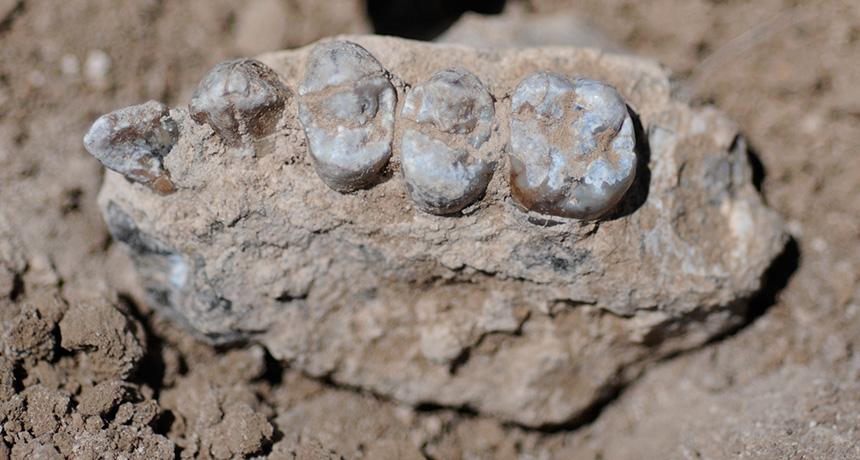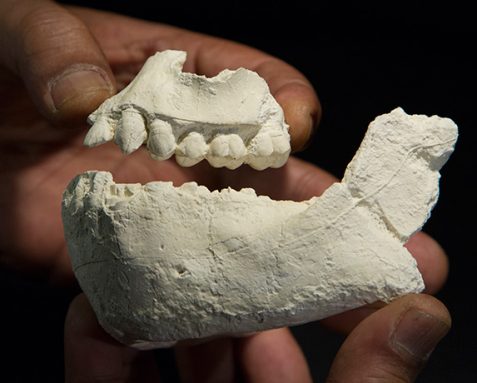Fossil find adds a relative to our family tree
Jawbones, teeth suggest species lived alongside other pre-humans

Fossils discovered in Ethiopia, including this partial upper jaw with teeth, come from a new species in the human evolutionary family. The ancient human relative lived between 3.3 million and 3.5 million years ago, alongside another pre-human species.
Y. HAILE-SELASSIE
By Bruce Bower
Scientists have discovered fossils of jawbones and teeth from what may be a new species on the human family tree. This distant human relative is long extinct. It lived between 3.3 million and 3.5 million years ago in what’s now Ethiopia.
Scientists have named the new species Australopithecus deyiremeda (Aw-STRAL-oh-PITH-eh-kus DAY-eer-REM-uh-dah). Researchers used a partial upper jaw and two lower jaws (one recovered in two pieces), to describe the species. (Deyiremeda means “close relative” in the local Afar language.)
Yohannes Haile-Selassie of the Cleveland Museum of Natural History in Ohio and his colleagues shared details of their new find May 28 in Nature.
|
Learn more about Australopithecus deyiremeda in this short video featuring Yohannes Haile-Selassie from the Cleveland Museum of Natural History. Cleveland Museum of Natural History/YouTube |
Paleoanthropologists like Haile-Selassie study ancient humans and their ancestors, based on fossils and cultural artifacts or symbols that they left behind. The new discovery suggests two or more species of ancient hominids coexisted in East Africa, Haile-Selassie says. (Hominids include humans and our fossil ancestors.) The new fossils were found near where another species of hominid lived at the same time. That species is best known by a partial skeleton nicknamed Lucy.
Species tend to adapt and change — sometimes so much so that they morph into a new species. The emergence of new traits, as part of that adaptation, usually comes in response to changes in the environment, food supply or perhaps climate. “The $64 million question,” says Haile-Selassie, “is ‘What environmental and ecological factors triggered hominid species diversity between around 4 million and 3 million years ago?’”
Is this really a new species?
Some researchers look at the new fossils and don’t see a new species. Instead, they argue that these remains likely come from Lucy’s kin. Lucy’s remains were found in 1974. Scientists now have about 400 fossils from her species,Australopithecus afarensis (AF-ar-EN-sis). They date to between roughly 2.9 million and 3.8 million years ago.
To Tim White of the University of California, Berkeley, any differences between the new fossils and those of Lucy’s kin are minor. “Lucy’s species just got a few more new fossils,” this paleoanthropologist concludes.

Researchers previously found a partial jaw and tooth belonging to yet a third hominid that lived around Lucy’s time. Called Australopithecus bahrelghazali (Bal-RELL-ga-ZAH-lee), too few of its remains exist for comparisons, Spoor says. Researchers found those fossils in a part of Central Africa now known as Chad.
What the new analyses show
Haile-Selassie’s team discovered the A. deyiremeda fossils in 2011. Eroding soil had revealed the jaws. Tests to gauge the age of an underlying ash layer helped to date the fossils.
A. deyiremeda had generally small teeth. It also apparently had a nearly flat face, much like an early Homo species. (Homo is the genus, or family, that includes modern humans.) The newfound fossils also had sturdy jaws and thick tooth enamel. These traits recall Paranthropus. That African hominid line existed from about 2.5 million to 1 million years ago. Together, these traits set apart A. deyiremeda from Lucy’s species, Haile-Selassie says.
Previously, a partial fossil foot was discovered near the new fossil find. That fossil also might belong to A. deyiremeda, Haile-Selassie adds. If true, then members of this species would have been flat-footed, making them walk more clumsily than Lucy would have. These feet also had grasping, gorilla-like big toes.
But the foot fossils simply might belong to some other hominid. If so, a third Australopithecus species might have lived in the region at the same time.
A. deyiremeda might have been an ancestor of Homo, Paranthropus or Australopithecus africanus, Haile-Selassie suggests. A. africanus lived in southern Africa about 3.3 million years ago.
It’s also possible that A. deyiremeda died out, leaving behind no descendants, says Scott Simpson. He’s a paleoanthropologist at Case Western Reserve University in Cleveland, Ohio. Like The Haile-Selassie, he does believe the new fossils are “reliably distinguishable” — meaning different — from Lucy’s kind.
Power Words
(for more about Power Words, click here)
diversity (in biology) A range of different life forms.
ecology A branch of biology that deals with the relations of organisms to one another and to their physical surroundings. A scientist who works in this field is called an ecologist.
enamel The glossy, hard substance that covers a tooth.
environment The sum of all of the things that exist around some organism or process and the conditions they create for that organism or process. Environment may refer to the weather and ecosystem in which some animal lives, or, perhaps, the temperature, humidity and placement of components in some electronics system or product.
erode Gradual removal of soil or stone, caused by the flow of water or the movement of winds.
extinct An adjective that describes a species for which there are no living members.
fossil Any preserved remains or traces of ancient life. There are many different types of fossils: The bones and other body parts of dinosaurs are called “body fossils.” Things like footprints are called “trace fossils.” Even specimens of dinosaur poop are fossils. The process of forming fossils is called fossilization.
hominid A primate of an animal family that includes humans and their fossil ancestors.
Homo A genus of species that includes modern humans (Homo sapiens). All had large brains and used tools. This genus is believed to have first evolved in Africa and over time its members continued to evolve and radiate throughout the rest of the world.
paleoanthropology The study of the culture of ancient people or human-like folk, based on the analysis of remnants, artifacts or markings created or used by these individuals. People who work in this field are known as paleoanthropologists.
species A group of similar organisms capable of producing offspring that can survive and reproduce.
trait A characteristic feature of something. (in genetics) A quality or characteristic that can be inherited.
tree of life A diagram that uses a branched, treelike structure to show how organisms relate to one another. Outer, twiglike, branches represent species alive today. Ancestors of today’s species will lie on thicker limbs, ones closer to the trunk.







